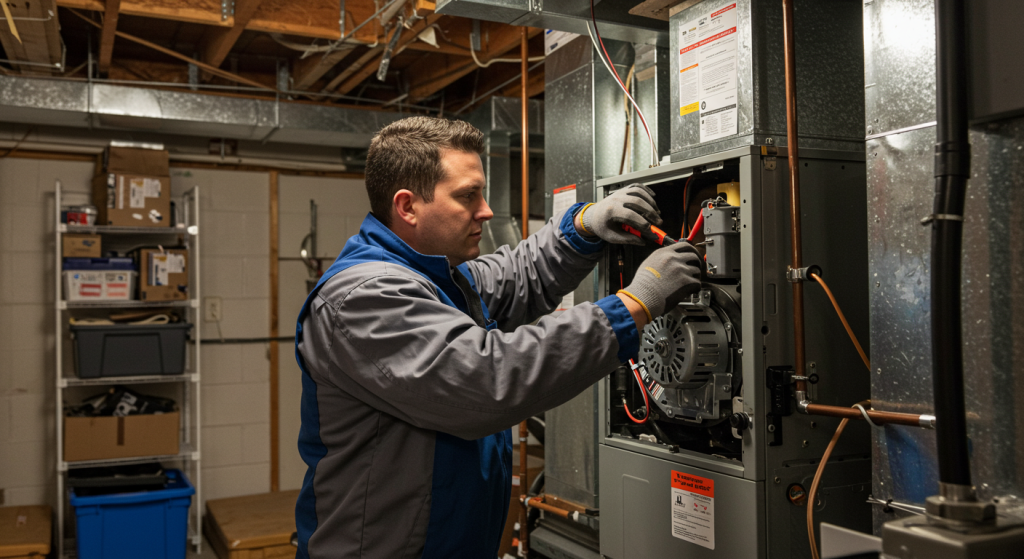At Obie Comfort Solutions, we understand how frustrating furnace problems can be, especially during the colder months. Our family-owned company, rooted in values of trust and professionalism, is here to help you identify and address furnace issues quickly and effectively. This guide covers the most common furnace problems and offers actionable solutions to keep your home warm and comfortable.

Key Takeaways
- Common furnace issues include airflow obstructions, ignition system failures, and thermostat malfunctions, which can lead to inefficiency and discomfort.
- Regular maintenance, such as changing air filters and cleaning vents, is essential for preventing costly repairs and ensuring optimal furnace performance.
- Noisy furnaces often signal underlying problems that should be addressed promptly to prevent further damage.
Identifying Common Furnace Problems
Imagine adjusting your thermostat, expecting a cozy home, only to find the house still cold. This frustrating scenario is often a sign of underlying furnace issues. Below are some of the most common problems homeowners face:
Airflow Obstructions
Airflow obstructions are a leading cause of furnace inefficiency. When air can’t circulate properly, your furnace works harder, leading to increased wear and tear.
- Dirty Air Filters: Dust-clogged filters force your furnace to overwork, reducing efficiency. Replace filters every 1–2 months, especially during high-usage seasons.
- Blocked Vents: Check vents for obstructions like furniture or heavy dust. Clearing these ensures even heating and proper airflow.
Ignition System Failures
Modern gas furnaces often use electric ignition systems, which can fail due to dirt or faulty components.
- Faulty Pilot Light: If your pilot light won’t stay lit, ensure the gas valve is open. Persistent issues may require cleaning the flame sensor or professional repairs.
- Electric Ignition Issues: Cracked ignitors or insufficient voltage can prevent startup. Seek professional inspection for these problems.
Blower Motor Issues
The blower motor circulates warm air through your home. If it fails, you may notice uneven heating or strange noises.
- Broken Blower Belt: A squealing noise often indicates a slipping or broken belt, which needs replacement by an HVAC technician.
- Worn Bearings: Scraping sounds suggest worn blower bearings, requiring immediate attention to avoid further damage.
Heat Exchanger Concerns
The heat exchanger warms the air before distribution. A cracked heat exchanger can release dangerous gases, such as carbon monoxide.
- Signs of a Cracked Heat Exchanger: Unusual odors, discolored flames, or soot buildup near burners indicate potential issues. Call a technician immediately for inspection and repair.
Thermostat Troubles
A malfunctioning thermostat disrupts heating cycles and may cause continuous running or no heating at all.
- Dead Batteries: Replace batteries if the display is blank.
- Faulty Wiring: Professional inspection is necessary for unresponsive thermostats or wiring issues.
Electrical Component Failures
Problems with the furnace’s electrical system can cause irregular heating or complete failure.
- Tripped Circuit Breaker: Reset the breaker if it trips. Persistent issues may indicate deeper electrical problems that require professional help.
- Malfunctioning Limit Switch: A faulty limit switch may keep the blower running continuously. Replace it promptly to prevent overheating.
Gas Supply Problems
Gas flow issues prevent your furnace from heating properly.
- Closed Gas Valve: Ensure the valve is open. If the pilot light won’t stay lit, consult a technician.
- Gas Leaks: If you smell gas, evacuate your home and contact your utility company immediately.
Condensate Drain Line Clogs
A clogged condensate drain line can cause water damage and disrupt furnace operation.
- Cleaning the Drain Line: Use a wet/dry vacuum or compressed air to clear blockages. Regular maintenance prevents future clogs.
Noisy Furnaces
Unusual noises, like banging or squealing, often signal mechanical issues. Ignoring these can lead to more costly repairs.
- Banging Sounds: Commonly caused by thermal expansion in ductwork, particularly in older systems. Regular maintenance minimizes this.
- Squealing or Grinding: These noises may indicate belt or bearing issues. Turn off the furnace and call a technician for repairs.
Preventative Furnace Maintenance Tips
Proactive maintenance is the best way to avoid breakdowns and keep your furnace running efficiently. Here’s how:
- Replace Filters Regularly: Change air filters every 1–3 months to maintain airflow.
- Inspect Ductwork: Seal leaks to prevent energy loss and ensure proper heating.
- Schedule Annual Inspections: A professional can identify and fix potential issues before they escalate.
- Check Pilot Light Color: A steady blue flame indicates normal operation; yellow or orange suggests a problem.
Summary
Addressing common furnace repair problems promptly can save you from discomfort and costly repairs. From airflow obstructions and ignition failures to thermostat and electrical issues, early detection and regular maintenance are key to a reliable heating system.
At Obie Comfort Solutions, we’re here to provide trusted, professional HVAC services tailored to your needs. Whether it’s routine maintenance or emergency repairs, you can count on our licensed, NATE-certified technicians to deliver exceptional service. Contact us today to ensure your furnace operates at peak performance throughout the winter.
Frequently Asked Questions
How often should I change my furnace filters?
Change furnace filters every 1–2 months during heavy usage periods to maintain efficiency and airflow.
What should I do if my furnace is making strange noises?
Turn off the furnace and contact a professional technician to inspect the issue. Strange noises often signal mechanical problems.
How can I tell if my heat exchanger is cracked?
Signs include unusual odors, yellow or orange flames, white soot near burners, and rattling or popping noises. Prompt inspection ensures safety.
What should I do if my pilot light won’t stay lit?
Ensure the gas valve is open and clean the flame sensor. If the issue persists, consult an HVAC technician.
How can I prevent my furnace from breaking down?
Regular maintenance, including filter changes, duct sealing, and annual professional inspections, helps prevent breakdowns and ensures efficient operation.
